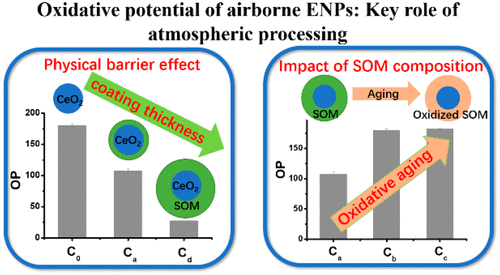当前位置:
X-MOL 学术
›
Environ. Sci. Technol. Lett.
›
论文详情
Our official English website, www.x-mol.net, welcomes your
feedback! (Note: you will need to create a separate account there.)
Understanding the Key Role of Atmospheric Processing in Determining the Oxidative Potential of Airborne Engineered Nanoparticles
Environmental Science & Technology Letters ( IF 8.9 ) Pub Date : 2019-12-17 , DOI: 10.1021/acs.estlett.9b00700 Qifan Liu 1 , Pourya Shahpoury 1 , John Liggio 1 , Tom Harner 1 , Kun Li 1 , Patrick Lee 1 , Shao-Meng Li 1
Environmental Science & Technology Letters ( IF 8.9 ) Pub Date : 2019-12-17 , DOI: 10.1021/acs.estlett.9b00700 Qifan Liu 1 , Pourya Shahpoury 1 , John Liggio 1 , Tom Harner 1 , Kun Li 1 , Patrick Lee 1 , Shao-Meng Li 1
Affiliation

|
Inhalation of airborne engineered nanoparticles (ENPs) is an important pathway for population exposure. While there have been numerous studies of the health impacts of pristine ENPs, the impacts of atmospherically transformed ENPs are largely unknown, despite the certainty that atmospheric processing of ENPs will occur. Here, the oxidative potential (OP) of TiO2, CeO2, and SiO2 nanoparticles which had been coated with atmospheric secondary organic material (SOM) from the OH or O3 oxidation of α-pinene and toluene was investigated. The results indicated that coating of these ENPs with SOM formed at low photochemical ages reduced the OP of redox-active ENPs (TiO2 and CeO2) and increased the OP of redox-inert ENP (SiO2). However, at a given SOM coating thickness, the overall OP of the particles increased by up to 93% with an increased level of photooxidation, regardless of ENP type. The OP suppression and enhancement observed here were attributed to a physical hindrance of ENP–antioxidant interactions by the SOM and an enhanced peroxide content in SOM (brought about by an increased level of photooxidation), respectively. These results imply that the health risk associated with airborne ENPs is strongly related to their time history during their residence time in the atmosphere, and thus, accounting for the impacts of atmospheric processing should be considered critical for making accurate risk assessments of airborne ENPs and for formulating efficient policies with respect to the control of emerging nanotechnologies.
中文翻译:

了解大气处理在确定机载工程纳米颗粒氧化电位中的关键作用
吸入机载工程化纳米颗粒(ENP)是人群暴露的重要途径。尽管已经对原始ENP的健康影响进行了许多研究,但是尽管可以确定ENP会在大气中进行处理,但大气转化的ENP的影响在很大程度上还是未知的。在这里,研究了由α--烯和甲苯的OH或O 3氧化而被大气二次有机材料(SOM)覆盖的TiO 2,CeO 2和SiO 2纳米颗粒的氧化电势(OP)。结果表明,在低光化学年龄下用SOM覆盖这些ENP会降低氧化还原活性ENP(TiO 2和CeO 2)并增加了氧化还原惰性ENP(SiO 2)。但是,在给定的SOM涂层厚度下,无论ENP类型如何,随着光氧化水平的提高,颗粒的总OP量最多可增加93%。此处观察到的OP抑制和增强分别归因于SOM对ENP-抗氧化剂相互作用的物理阻碍和SOM中过氧化物含量的增加(由光氧化水平的提高所致)。这些结果表明,与机载ENP相关的健康风险与其在大气中停留时间的时间历史密切相关,因此,应考虑考虑大气处理的影响对于准确评估机载ENP和制定有关新兴纳米技术控制的有效政策。
更新日期:2019-12-18
中文翻译:

了解大气处理在确定机载工程纳米颗粒氧化电位中的关键作用
吸入机载工程化纳米颗粒(ENP)是人群暴露的重要途径。尽管已经对原始ENP的健康影响进行了许多研究,但是尽管可以确定ENP会在大气中进行处理,但大气转化的ENP的影响在很大程度上还是未知的。在这里,研究了由α--烯和甲苯的OH或O 3氧化而被大气二次有机材料(SOM)覆盖的TiO 2,CeO 2和SiO 2纳米颗粒的氧化电势(OP)。结果表明,在低光化学年龄下用SOM覆盖这些ENP会降低氧化还原活性ENP(TiO 2和CeO 2)并增加了氧化还原惰性ENP(SiO 2)。但是,在给定的SOM涂层厚度下,无论ENP类型如何,随着光氧化水平的提高,颗粒的总OP量最多可增加93%。此处观察到的OP抑制和增强分别归因于SOM对ENP-抗氧化剂相互作用的物理阻碍和SOM中过氧化物含量的增加(由光氧化水平的提高所致)。这些结果表明,与机载ENP相关的健康风险与其在大气中停留时间的时间历史密切相关,因此,应考虑考虑大气处理的影响对于准确评估机载ENP和制定有关新兴纳米技术控制的有效政策。











































 京公网安备 11010802027423号
京公网安备 11010802027423号